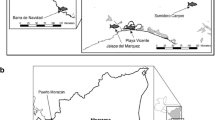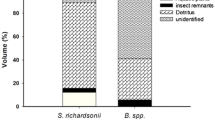Abstract
Total mercury (THg) and methylmercury (MHg) concentrations and determents of mercury (Hg) accumulation were examined for muscle tissues of 10 finfish from the lower Chesapeake Bay (LCB) and its tributaries. There was no suggestion of potential human harm from Hg due to LCB fish consumption: None of the sampled fish had THg concentrations approaching the United States Environmental Protection Agency human health screening value. Hg concentrations in different fish species generally increased with the increasing stable isotope of nitrogen 15 (δ15N) but not the stable isotope of carbon 13 (δ13C), thus suggesting that trophic position but not dietary carbon source is a dominant determinant. An MHg biomagnification model was built to estimate a food web magnification factor of approximately 10-fold increase per trophic level. Based on otolith strontium-to-calcium ratios, Atlantic croaker inhabiting less saline waters might accumulate more Hg than those inhabiting more saline waters. The SAS mixed procedure identified significant positive intraspecies relationships between MHg concentration and δ13C for summer flounder, weakfish, American eel, Atlantic croaker, and spot.




Similar content being viewed by others
References
Altman DG (2000) Confidence intervals in practice. In: Altman D, Machin D, Bryant TN, Gardner MJ (eds) Statistics with confidence: confidence intervals and statistical guidelines. British Medical Journal Books, London, pp 6–14
Altman M (2004) Statistical significance, path dependency, and the culture of journal publication. J Sociocon 33:651–663
Anderson DR, Burnham KP, Thompson WL (2000) Null hypothesis testing: problems, prevalence, and an alternative. J Wildl Manag 64:912–923
Baird D, Ulanowicz RE (1989) The seasonal dynamics of the Chesapeake Bay ecosystem. Ecol Monogr 59:329–364
Benson NU, Essien JP, Williams AB, Bassey DE (2007) Mercury accumulation in fishes from tropical aquatic ecosystems in the Niger Delta, Nigeria. Curr Sci 92:781–785
Bodaly RA, Hecky RE, Fudge RJ (1984) Increases in fish mercury levels in lakes flooded by the Churchill River diversion, Northern Manitoba. Can J Fish Aquat Sci 41:682–691
Burger J, Gaines KF, Boring SC, Stephens WL Jr, Snodgrass J, Gochfeld M (2001) Mercury and selenium in fish from the Savannah River: species, trophic level, and locational differences. Environ Res 87:108–118
Cabana G, Rasmussen JB (1994) Modeling food chain structure and contaminant bioaccumulation using stable N-isotopes. Nature 372:255–257
Cizdziel JV, Hinners TA, Pollard JE, Heithmar EM, Cross CL (2002) Mercury concentrations in fish from Lake Mead, USA, related to fish size, condition, trophic level, location, and consumption risk. Arch Environ Contam Toxicol 43:309–317
Cumming G (2012) Understanding the new statistics: effect sizes, confidence intervals, and meta-analysis. Routledge Taylor & Francis Group, New York, pp 53–118
Cumming G, Finch S (2005) Inference by eye. Am Psychol 60:170–180
Fidler F, Burgman MA, Cumming G, Buttrose R, Thomason N (2006) Impact of criticism of null-hypothesis significance testing on statistical reporting practices in conservation biology. Conserv Biol 20:1539–1544
Fry B (1988) Food web structure on Georges Bank from stable C, N, and S isotopic compositions. Limnol Oceanogr 33:1182–1190
Füreder L, Welter C, Jackson JK (2003) Dietary and stable isotope (δ 13C, δ 15N) analyses in Alpine stream insects. Int Rev Hydrobiol 88:314–331
Gigerenzer G (2004) Mindless statistics. J Socioecon 33:399–417
Ginsberg GL, Toal BF (2009) Quantitative approach for incorporating methylmercury risks and omega-3 fatty acid benefits in developing species-specific fish consumption advice. Environ Health Perspect 117:267–275
Grieb TM, Bowie GL, Driscoll CT, Gloss SP, Schofield CL, Porcella DB (1990) Factors affecting mercury accumulation in fish in the upper Michigan peninsula. Environ Toxicol Chem 9:919–930
Hammerschmidt CR, Fitzgerald WF (2006) Bioaccumulation and trophic transfer of methylmercury in Long Island Sound. Arch Environ Contam Toxicol 51:416–424
Holloman EL, Newman MC (2010) A community-based assessment of seafood consumption along the lower James River, Virginia, USA: potential sources of dietary mercury exposure. Environ Res 110:213–219
Holloman EL, Newman MC (2012) Expanding perceptions of subsistence fish consumption: evidence of high commercial fish consumption and dietary mercury exposure in an urban coastal community. Sci Total Environ 416:111–120
Jæger I, Hop H, Gabrielsen GW (2009) Biomagnification of mercury in selected species from an Arctic marine food web in Svalbard. Sci Total Environ 407:4744–4751
Kalish JM (1989) Otolith microchemistry: validation of the effects of physiology, age and environment on otolith composition. J Exp Mar Biol Ecol 132:151–178
Kraus RT, Secor DH (2004) Incorporation of strontium into otoliths of an estuarine fish. J Exp Mar Biol Ecol 302:85–106
Lamborg CH, Balcom PH, Fitzgerald WF, Damman AWH, Benoit JM, Engstrom DR (2002) Modern and historic atmospheric mercury fluxes in both hemispheres: Global and regional mercury cycling implications. Glob Biogeochem Cy 16:1104
Liang L, Bloom NS, Horvat M (1994a) Simultaneous determination of mercury speciation in biological materials by GC/CVAFS after ethylation and room temperature precollection. Clin Chem 40:602–607
Liang L, Horvat M, Bloom NS (1994b) An improved speciation method for mercury by GC/CVAFS after aqueous phase ethylation and room temperature precollection. Talanta 41:371–379
Lin Y, Guo M, Gan W (1997) Mercury pollution from small gold mines in China. Water Air Soil Pollut 97:233–239
Manohar DM, Krishnan KA, Anirudhan TS (2002) Removal of mercury (II) from aqueous solutions and chlor-alkali industry wastewater using 2-mercaptobenzimidazole-clay. Water Res 36:1609–1619
Mason RP, Heyes D, Sveinsdottir A (2006) Methylmercury concentrations in fish from tidal waters of the Chesapeake Bay. Arch Environ Contam Toxicol 51:425–437
Mason RP, Lawson NM, Lawrence AL, Leaner JJ, Lee JG, Sheu GR (1999) Mercury in the Chesapeake Bay. Mar Chem 65:77–96
Minagawa M, Wada E (1984) Stepwise enrichment of 15N along food chains: further evidence and the relation between 15 N and animal age. Geochim Cosmochim Acta 48:1135–1140
Montoya JP, Wiebe PH, McCarthy JJ (1990) Natural abundance of 15N particulate nitrogen and zooplankton in the Chesapeake Bay. Mar Ecol Prog Ser 65:35–61
Murdy EO, Birdsong RS, Musick JA (1997) Fishes of Chesapeake Bay. Smithsonian Institution Press, Washington, DC, pp 193–194
Newman MC, Xu X, Condon A, Liang L (2011a) Floodplain methylmercury biomagnification factor higher than that of the contiguous river (South River, Virginia USA). Environ Pollut 159:2840–2844
Newman MC, Xu X, Cotton CF, Tom KR (2011b) High mercury concentrations reflect trophic ecology of three deep-water chondrichthyans. Arch Environ Contam Toxicol 60:618–625
Oken E, Wright RO, Kleinman KP, Bellinger D, Amarasiriwardena CJ, Hu H, Rich-Edwards JW, Gillman MW (2005) Maternal fish consumption, hair mercury and infant cognition in a US cohort. Environ Health Perspect 113:1376–1380
Power M, Klein GM, Guiguer KRRA, Kwan MKH (2002) Mercury accumulation in the fish community of a sub-Arctic lake in relation to trophic position and carbon sources. J Appl Ecol 39:819–830
Schloesser RW, Fabrizio MC, Latour RJ, Garman GC, Greenlee B, Groves M, Gartland J (2011) Ecological role of blue catfish in Chesapeake Bay communities and implications for management. In: Michaletz P, Travnichek V (eds) Conservation, ecology, and management of worldwide catfish populations and habitats. American Fisheries Society Symposium 77:369–382
Schuster PF, Krabbenhoft DP, Naftz DL, Cecil LD, Olson ML, Dewild JF et al (2002) Atmospheric mercury deposition during the last 270 years: A glacial ice core record of natural and anthropogenic sources. Environ Sci Technol 36:2303–2310
Secor DH (1999) Specifying divergent migrations in the concept of stock: the contingent hypothesis. Fish Res 43:13–34
Secor DH, Henderson-Arzapalo A, Piccoli PM (1995) Can otolith microchemistry chart patterns of migration and habitat utilization in anadromous fishes. J Exp Mar Biol Ecol 192:15–33
Secor DH, Rooker JR, Zlokovitz E, Zdanowicz VS (2001) Identification of riverine, estuarine, and coastal contingents of Hudson River striped bass based upon otolith elemental fingerprints. Mar Ecol Prog Ser 211:245–253
Seigneur C, Vijayaraghavan K, Lohman K, Karamchandani P, Scott C (2004) Global source attribution for mercury deposition in the United States. Environ Sci Technol 38:555–569
Sterne JA, Davey Smith G (2001) Sifting the evidence—What’s wrong with significance tests? Br Med J 322:226–230
Sveinsdottir AY, Mason RP (2005) Factors controlling mercury and methylmercury concentrations in largemouth bass (Micropterus salmoides) and other fish from Maryland reservoirs. Arch Environ Contam Toxicol 49:528–545
Tom KR, Newman MC, Schmerfeld J (2010) Modeling mercury biomagnification (South River, Virginia, USA) to inform river management decision making. Environ Toxicol Chem 29:1013–1020
Tuckey TD, Fabrizio MC (2011) Estimating relative juvenile abundance of ecologically important finfish in the Virginia portion of Chesapeake Bay. Annual report to the Virginia Marine Resources Commission
United States Environmental Protection Agency (USEPA) (1998) Method 1630: Methyl mercury in water by distillation, aqueous ethylation, purge and trap, and cold vapor atomic fluorescence spectrometry
United States Environmental Protection Agency (USEPA) (2004) National listing of fish advisories, EPA-823-F-04-016
United States Environmental Protection Agency (USEPA) (2009) Fish contamination in US lakes and reservoirs, EPA-823-F-09-008
United States Food and Drug Administration (2011) Mercury concentrations in fish: FDA monitoring program (1990–2010). Available at: http://www.fda.gov/Food/FoodSafety/Product-SpecificInformation/Seafood/FoodbornePathogensContaminants/Methylmercury/ucm191007.htm. Accessed: 11 Sep 2012
Van der Velden S, Dempson JB, Evans MS, Muir DCG, Power M (2013) Basal mercury concentrations and biomagnification rates in freshwater and marine food webs: Effects on Arctic charr (Salvelinus alpinus) from eastern Canada. Sci Total Environ 444:531–542
Virginia Department of Environmental Quality (2008) Fish tissue analysis for metals 2008. Available at: http://www.deq.virginia.gov/Portals/0/DEQ/Water/WaterQualityMonitoring/FishSedimentMonitoring/2008_fish_metals.xls. Accessed 11 Sep 2012
Wang J, Newmana MC, Xu X, Liang L (2013) Higher and more variable methylmercury biomagnification factors for floodplain than the contiguous river (South River, Virginia USA). Ecotoxicol Environ Saf 92:191–198
Yan H, Rustadbakken A, Yao H, Larssen T, Feng X, Liu T et al (2010) Total mercury in wild fish in Guizhou reservoirs, China. J Environ Sci 22:1129–1136
Acknowledgments
Jochen Zubrod and Frank Seitz processed and analyzed THg for the first 160 fish samples. The following individuals from the VIMS Juvenile Fish Trawl Survey team contributed to the field sampling: H. Brooks, J. Greaney, A. Halvorson, W. Lowery, R. Norris, and T. Tuckey. Funding for the VIMS Juvenile Fish Trawl Survey was provided by the Virginia Marine Resources Commission and the United States Fish and Wildlife Service. Funding for the analytical work was provided by the Virginia Sea Grant. This paper is Contribution No. 3280 of the Virginia Institute of Marine Science, The College of William and Mary.
Author information
Authors and Affiliations
Corresponding author
Rights and permissions
About this article
Cite this article
Xu, X., Newman, M.C., Fabrizio, M.C. et al. An Ecologically Framed Mercury Survey of Finfish of the Lower Chesapeake Bay. Arch Environ Contam Toxicol 65, 510–520 (2013). https://doi.org/10.1007/s00244-013-9917-1
Received:
Accepted:
Published:
Issue Date:
DOI: https://doi.org/10.1007/s00244-013-9917-1




